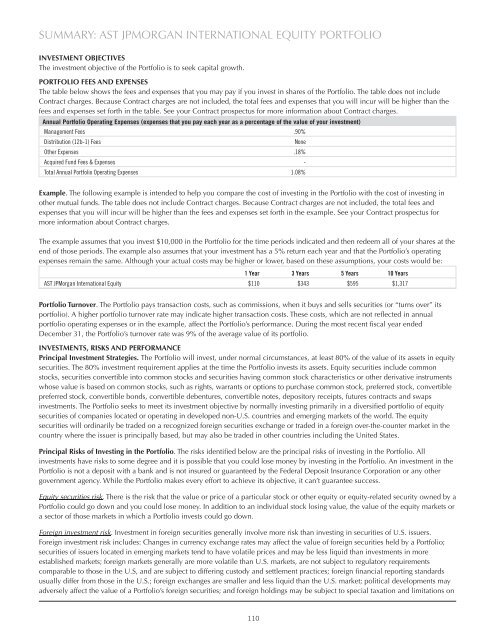Advanced Series Trust AST Academic Strategies Asset ... - Prudential
Advanced Series Trust AST Academic Strategies Asset ... - Prudential
Advanced Series Trust AST Academic Strategies Asset ... - Prudential
You also want an ePaper? Increase the reach of your titles
YUMPU automatically turns print PDFs into web optimized ePapers that Google loves.
SUMMARY: <strong>AST</strong> JPMORGAN INTERNATIONAL EQUITY PORTFOLIO<br />
INVESTMENT OBJECTIVES<br />
The investment objective of the Portfolio is to seek capital growth.<br />
PORTFOLIO FEES AND EXPENSES<br />
The table below shows the fees and expenses that you may pay if you invest in shares of the Portfolio. The table does not include<br />
Contract charges. Because Contract charges are not included, the total fees and expenses that you will incur will be higher than the<br />
fees and expenses set forth in the table. See your Contract prospectus for more information about Contract charges.<br />
Annual Portfolio Operating Expenses (expenses that you pay each year as a percentage of the value of your investment)<br />
Management Fees .90%<br />
Distribution (12b-1) Fees<br />
Other Expenses .18%<br />
Acquired Fund Fees & Expenses -<br />
Total Annual Portfolio Operating Expenses 1.08%<br />
None<br />
Example. The following example is intended to help you compare the cost of investing in the Portfolio with the cost of investing in<br />
other mutual funds. The table does not include Contract charges. Because Contract charges are not included, the total fees and<br />
expenses that you will incur will be higher than the fees and expenses set forth in the example. See your Contract prospectus for<br />
more information about Contract charges.<br />
The example assumes that you invest $10,000 in the Portfolio for the time periods indicated and then redeem all of your shares at the<br />
end of those periods. The example also assumes that your investment has a 5% return each year and that the Portfolio’s operating<br />
expenses remain the same. Although your actual costs may be higher or lower, based on these assumptions, your costs would be:<br />
1 Year 3 Years 5 Years 10 Years<br />
<strong>AST</strong> JPMorgan International Equity $110 $343 $595 $1,317<br />
Portfolio Turnover. The Portfolio pays transaction costs, such as commissions, when it buys and sells securities (or “turns over” its<br />
portfolio). A higher portfolio turnover rate may indicate higher transaction costs. These costs, which are not reflected in annual<br />
portfolio operating expenses or in the example, affect the Portfolio’s performance. During the most recent fiscal year ended<br />
December 31, the Portfolio’s turnover rate was 9% of the average value of its portfolio.<br />
INVESTMENTS, RISKS AND PERFORMANCE<br />
Principal Investment <strong>Strategies</strong>. The Portfolio will invest, under normal circumstances, at least 80% of the value of its assets in equity<br />
securities. The 80% investment requirement applies at the time the Portfolio invests its assets. Equity securities include common<br />
stocks, securities convertible into common stocks and securities having common stock characteristics or other derivative instruments<br />
whose value is based on common stocks, such as rights, warrants or options to purchase common stock, preferred stock, convertible<br />
preferred stock, convertible bonds, convertible debentures, convertible notes, depository receipts, futures contracts and swaps<br />
investments. The Portfolio seeks to meet its investment objective by normally investing primarily in a diversified portfolio of equity<br />
securities of companies located or operating in developed non-U.S. countries and emerging markets of the world. The equity<br />
securities will ordinarily be traded on a recognized foreign securities exchange or traded in a foreign over-the-counter market in the<br />
country where the issuer is principally based, but may also be traded in other countries including the United States.<br />
Principal Risks of Investing in the Portfolio. The risks identified below are the principal risks of investing in the Portfolio. All<br />
investments have risks to some degree and it is possible that you could lose money by investing in the Portfolio. An investment in the<br />
Portfolio is not a deposit with a bank and is not insured or guaranteed by the Federal Deposit Insurance Corporation or any other<br />
government agency. While the Portfolio makes every effort to achieve its objective, it can’t guarantee success.<br />
Equity securities risk. There is the risk that the value or price of a particular stock or other equity or equity-related security owned by a<br />
Portfolio could go down and you could lose money. In addition to an individual stock losing value, the value of the equity markets or<br />
a sector of those markets in which a Portfolio invests could go down.<br />
Foreign investment risk. Investment in foreign securities generally involve more risk than investing in securities of U.S. issuers.<br />
Foreign investment risk includes: Changes in currency exchange rates may affect the value of foreign securities held by a Portfolio;<br />
securities of issuers located in emerging markets tend to have volatile prices and may be less liquid than investments in more<br />
established markets; foreign markets generally are more volatile than U.S. markets, are not subject to regulatory requirements<br />
comparable to those in the U.S, and are subject to differing custody and settlement practices; foreign financial reporting standards<br />
usually differ from those in the U.S.; foreign exchanges are smaller and less liquid than the U.S. market; political developments may<br />
adversely affect the value of a Portfolio’s foreign securities; and foreign holdings may be subject to special taxation and limitations on<br />
110

















